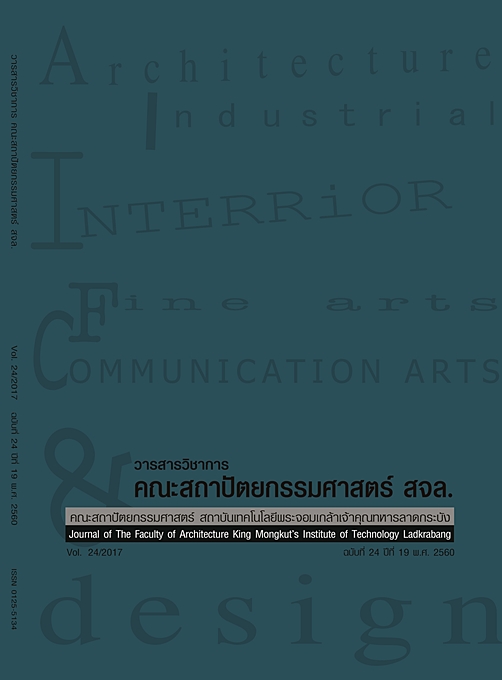การออกแบบและก่อสร้างบ้านรูปแบบจอร์เจียนในภูมิอากาศร้อนชื้น: Georgian House Design and Construction in Tropical Climate
Main Article Content
บทคัดย่อ
บทคัดย่อ
งานออกแบบและก่อสร้างงานสถาปัตยกรรมในรูปแบบจอร์เจียนนั้น โดยส่วนใหญ่จะเป็นอาคารที่อยู่ในพื้นที่เขตหนาวและดูมีเอกลักษณ์ของประเทศอังกฤษ หรือในดินแดนทางตอนเหนือของประเทศสหรัฐอเมริกา เป็นรูปแบบที่เริ่มมีในสมัยพระเจ้าจอร์จที่ 4 ของประเทศอังกฤษในช่วงปี ค.ศ. 1700 ถึง ค.ศ. 1830 ผ่านมาถึงปีปัจจุบัน พ.ศ. 2560 กว่าสองร้อยกว่าปีการออกแบบงานสถาปัตยกรรมรูปแบบนี้ในประเทศไทย ที่มีสภาพอากาศแตกต่าง รวมถึงวิถีชีวิตและวัฒนธรรมที่เป็นอยู่ในปัจจุบันนั้น ที่แตกต่างกันอย่างสิ้นเชิงกับงานเดิม นับเป็นความท้าทาย รวมถึงต้องปรับกระบวนการออกแบบและการก่อสร้าง
ให้มีความเหมาะสมกับภูมิอากาศร้อนชื้นของประเทศไทย
ในกระบวนการออกแบบนั้นจะนำรูปลักษณ์ภายนอก รวมถึงวัสดุให้มีความคล้ายคลึงกับของเดิมมาปรับใช้ แต่การออกแบบรายละเอียดนั้นได้ปรับให้เหมาะสมกับยุคปัจจุบัน เช่น การออกแบบผนังบ้านสองชั้นเพื่อป้องกันอุณหภูมิอากาศร้อนไม่ให้ไหลเข้ามา มีความแตกต่างจากเมืองนอกที่ป้องกันอุณหภูมิอากาศเย็นไม่ให้เข้ามาภายใน การใช้ระบบปิด ภายในอาคารเพื่อควบคุมอุณหภูมิ รวมถึงความชื้น และก็ได้ออกแบบระบบที่สามารถเปลี่ยนถ่ายอากาศให้มีความบริสุทธิ์อยู่เสมอ การใช้ปล่องควันไฟบนหลังคาเพื่อระบายความร้อนที่เกิดขึ้นในชั้นใต้หลังคาเพื่อทำให้บ้านเย็นลง รวมถึงเทคนิควิธีการอื่นๆ ที่นำมาใช้เพื่อใช้กับสภาพภูมิอากาศในประเทศไทย งานก่อสร้างก็เช่นเดียวกันก็จำเป็นที่จะต้องปรับวิธีการเพื่อให้มีความเหมาะสม เช่น การใช้โครงสร้างเสาและคาน แทนการใช้กำแพงก่อรับน้ำหนัก การตอกเข็มเนื่องจากสภาพดิน ฯลฯ
การที่ได้ทำงานออกแบบจริงนั้นเป็นความจำเป็นในสายวิชาชีพ โดยเฉพาะการเป็นผู้สอน เพื่อให้ได้รับประสบการณ์ในการทำงานวิชาชีพสถาปัตยกรรมตั้งแต่การคุยงานกับลูกค้า คุยกับวิศวกร รวมถึงผู้รับเหมา และดูแลแก้ไขงานจนสำเร็จลุล่วง สำหรับงานชิ้นนี้ เป็นอีกหนึ่งงานที่ได้เรียนรู้และสร้างสรรค์งานสถาปัตยกรรมรูปแบบจอร์เจียนในประเทศไทย
คำสำคัญ: สถาปัตยกรรมจอร์เจียน การออกแบบบ้าน การก่อสร้าง ภูมิอากาศร้อนชื้น แนวคิดในการออกแบบ
Abstract
Architectural design and construction on Georgian House which the style is the British and style of the Northern part of the United State of America, especially built in the cold climate. This architectural style originate from King George 4th of England, during 1700-1830 AD. This style has been well known for more than 200 years. Design and build this style of Architecture in Thailand requires adjustment, because the weather is completely different, form the cold climate to the tropical zone. It is a challenge in the design process and the building technique to fit in the tropical climate.
During the design process, the main character of Georgian has been used through out. The adaptation of double wall thickness has been used for protection from the hot sun, and kept the cool air inside. This house is a close system of insulated wall and opening. The heat exchanger is used to supply fresh air without losing the cold temperature of the house. The chimney on the roof top is used as a ventilation of hot air that build up in the attic, not for smoke of fire place as in the original Georgian Design. The construction of post
and beam used in instead of wall bearing of the old day. The pile foundation is used for sub-structure.
The experience from designing this architecture project is a valuable lesson. It is an important process from the design to the finished the Georgian House. For this project, it is one of many architectural experience to create an architectural environment for Bangkok, Thailand.
Keywords: Georgian Architecture, Housing Design, Construction, Tropical Climate, Conceptual Design
Article Details
This work is licensed under a Creative Commons Attribution-NonCommercial-ShareAlike 4.0 International License.
Copyright Transfer Statement
The copyright of this article is transferred to Journal of The Faculty of Architecture King Mongkut's Institute of Technology Ladkrabang with effect if and when the article is accepted for publication. The copyright transfer covers the exclusive right to reproduce and distribute the article, including reprints, translations, photographic reproductions, electronic form (offline, online) or any other reproductions of similar nature.
The author warrants that this contribution is original and that he/she has full power to make this grant. The author signs for and accepts responsibility for releasing this material on behalf of any and all co-authors.


